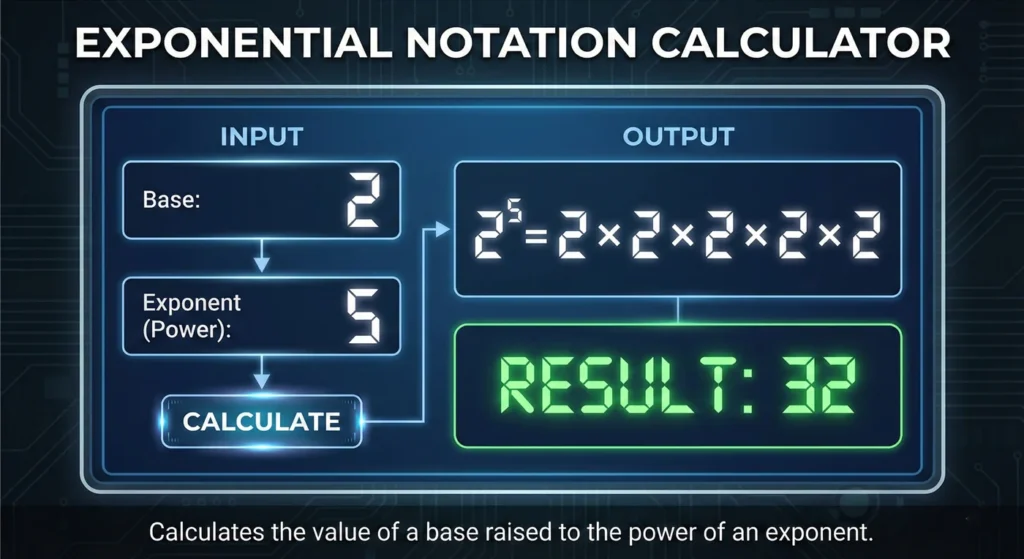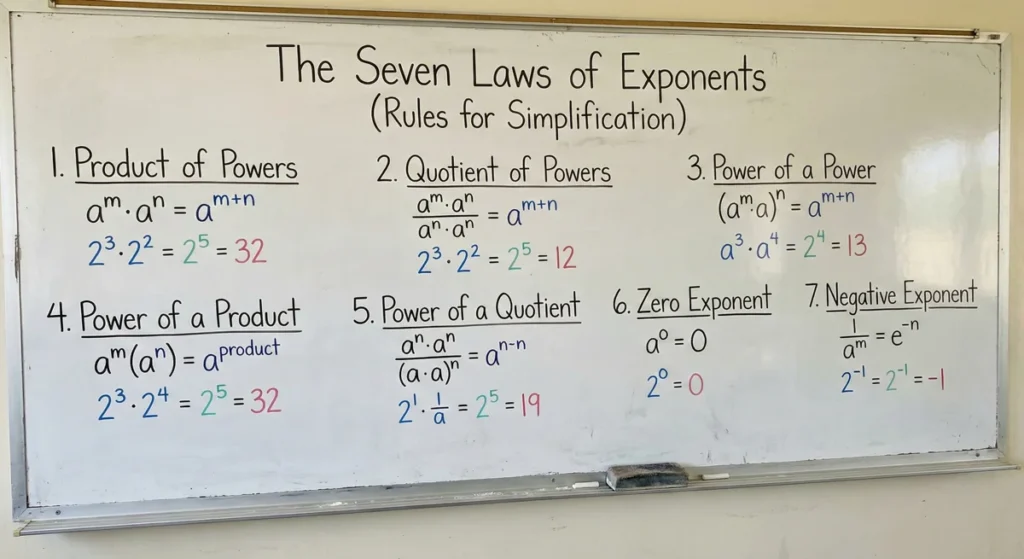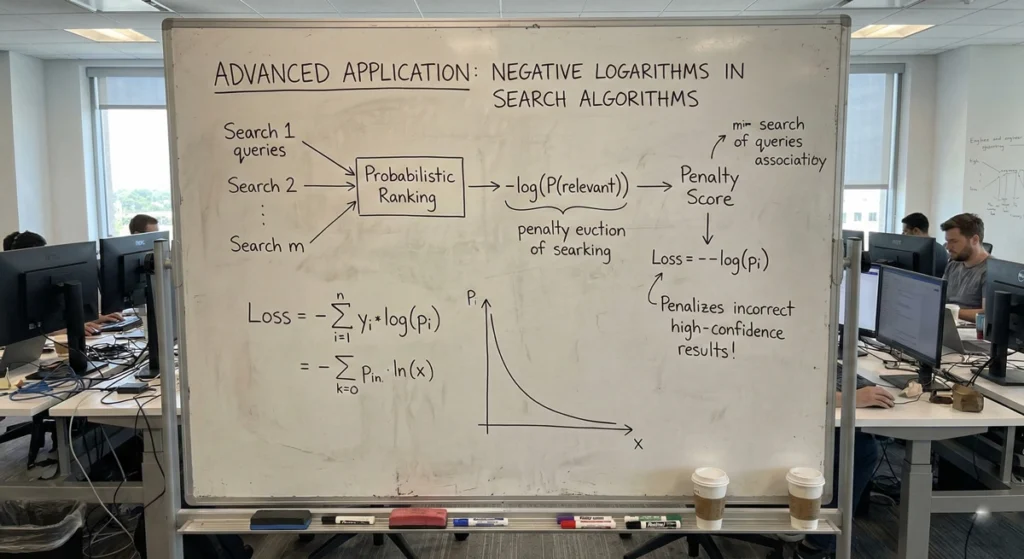Ever tried writing out the size of the Milky Way or the tiny radius of a hydrogen atom in regular numbers? It’s a nightmare — hundreds of zeros, a pain to read, and a headache to calculate with. That’s where exponential notation swoops in to save the day. It’s like the superhero of math, turning monstrous numbers into neat, manageable expressions. And if doing the math sounds tricky, an Exponential Notation Calculator can make converting these huge or tiny numbers quick and painless.
Simply put, exponential notation is a way to express numbers by showing how many times a base number multiplies itself. It helps you handle huge numbers or teeny tiny ones without breaking a sweat. And trust me, once you grasp this, solving powers and equations becomes way less painful.
- Why Exponents Matter
- Fundamental Concepts and Terminology
- The Seven Laws of Exponents (Rules for Simplification)
- Step-by-Step Simplification of Algebraic Expressions
- Scientific Notation (Standard Form) in Science and Math
- Common Errors and Pitfalls (Maximizing Clarity for Students)
- Advanced Application: Negative Logarithms in Search Algorithms
- Teaching and Visualization Tools
- The Enduring Power of Exponential Thinking
Why Exponents Matter
Let’s face it – some numbers are just ridiculous to write out. Imagine jotting down the number of atoms in your body (about 7,000,000,000,000,000,000,000,000,000) or the size of a virus (0.000000015 meters). Yikes!
Exponential notation gives us a shorthand way to express these mind-boggling values without filling entire pages with zeros. Beyond just saving space, it makes these numbers way easier to work with, compare, and use in calculations.
At its heart, exponential notation is just a clever way of showing repeated multiplication. Instead of writing 5 × 5 × 5 × 5, we can simply write 5⁴. Much cleaner, right?
Fundamental Concepts and Terminology

Before we dive deeper, let’s get our lingo straight:
- The Power: This is the whole expression (like 2³) representing repeated multiplication
- The Base: The number getting multiplied by itself (the “2” in 2³)
- The Exponent: That little superscript number (the “3” in 2³) telling us how many times to use the base as a factor
For example, when you see 6⁴, it means 6 × 6 × 6 × 6, which equals 1,296. We’d read this as “six to the fourth power” or “six to the power of four.”
Fun fact: You probably already know some special cases! 3² is “three squared” and 3³ is “three cubed” – terms that actually come from geometry (square and cube shapes).
Most of us first encounter exponential notation around 8th grade when math teachers start throwing expressions like x² + 3x + 2 our way. But mastering it opens doors to understanding everything from compound interest to bacterial growth!
The Seven Laws of Exponents (Rules for Simplification)

Think of these seven rules as the cheat codes for working with exponents. Master them, and you’ll breeze through algebra problems like a math wizard!
- Product of Powers Rule: When multiplying powers with the same base, keep the base and add the exponents.Code
4² × 4³ = 4²⁺³ = 4⁵ = 1,024Translation: Instead of calculating 16 × 64, we can just add 2 + 3 and get 4⁵! - Quotient Rule of Exponents: When dividing powers with the same base, keep the base and subtract the exponents.Code
4⁶ ÷ 4⁴ = 4⁶⁻⁴ = 4² = 16This is like magic – dividing 4,096 by 256 becomes as simple as 6 – 4 = 2! - Power of a Power Rule: When raising a power to another power, multiply the exponents.Code
(4²)⁴ = 4²×⁴ = 4⁸ = 65,536We’re essentially saying (16)⁴, which equals 4⁸. - Zero Exponent Rule: Any non-zero number with an exponent of 0 equals 1.Code
12⁰ = 1This one might seem weird at first, but it’s crucial for making other exponent rules work consistently. - Negative Exponent Rule: A negative exponent means “take the reciprocal” (flip the fraction).Code
5⁻² = 1/5² = 1/25 = 0.04This is super handy for working with fractions and decimals. - Power of a Product Rule: When raising a product to a power, distribute the exponent to each factor.Code
(xy)⁴ = x⁴y⁴So (3×2)³ = 3³×2³ = 27×8 = 216 - Power of a Quotient Rule: When raising a fraction to a power, distribute the exponent to both numerator and denominator.Code
(x/y)⁴ = x⁴/y⁴For example, (2/3)² = 2²/3² = 4/9
These laws work for ALL exponents – positive, negative, or zero – which makes them incredibly powerful tools!
Step-by-Step Simplification of Algebraic Expressions
Now let’s put these rules to work in real algebraic expressions. The key is identifying which rule applies when:
Example 1: Multiplication with Variables
Code
3x² × 4x³
Step 1: Multiply the coefficients: 3 × 4 = 12 Step 2: Use the Product of Powers Rule for the variable: x² × x³ = x²⁺³ = x⁵ Step 3: Combine results: 12x⁵
Example 2: Division with Variables
Code
10y⁶ ÷ 5y⁴
Step 1: Divide the coefficients: 10 ÷ 5 = 2 Step 2: Use the Quotient Rule for the variable: y⁶ ÷ y⁴ = y⁶⁻⁴ = y² Step 3: Combine results: 2y²
Example 3: Power of a Product
Code
(2z³)⁵
Step 1: Apply the exponent to the coefficient: 2⁵ = 32 Step 2: Apply the Power of a Power Rule to the variable: (z³)⁵ = z³×⁵ = z¹⁵ Step 3: Combine results: 32z¹⁵
The trick is breaking complex expressions down into simpler parts you can tackle with these rules. With practice, you’ll start to see patterns and shortcuts!
Scientific Notation (Standard Form) in Science and Math
Ever wonder how scientists express mind-blowingly large or tiny numbers? Enter scientific notation – exponential notation’s practical cousin that scientists and engineers use constantly.
Scientific notation writes numbers as a coefficient between 1 and 10, multiplied by 10 raised to some power.
Code
Regular number: 6,020,000,000,000,000,000,000,000
Scientific notation: 6.02 × 10²³ (Avogadro's constant)
Much cleaner, right? Here’s how the exponent tells you about the number’s size:
- Positive exponent (like 10²): Number is 10 or larger
- Zero exponent (10⁰): Number is between 1 and 10
- Negative exponent (like 10⁻²): Number is between 0 and 1
Converting from Decimal to Scientific Notation:
- Find the first significant digit (first non-zero digit)
- Move the decimal point right after this digit
- Count how many places you moved the decimal point
- If you moved it left, the exponent is positive; if right, negative
Example: Convert 0.00000456 to scientific notation
- First significant digit is 4
- Move decimal after 4: 4.56
- We moved 6 places to the right
- Since we moved right, exponent is negative: 4.56 × 10⁻⁶
Converting from Scientific Notation to Decimal:
- Take the coefficient
- Move the decimal point according to the exponent (right for positive, left for negative)
- Fill in with zeros as needed
Example: Convert 3.75 × 10⁴ to decimal
- Start with 3.75
- Exponent is +4, so move decimal 4 places right
- Result: 37,500
Pro Tip: When comparing numbers in scientific notation, first compare the exponents. The number with the larger exponent is bigger. If the exponents are equal, then compare the coefficients.
Common Errors and Pitfalls (Maximizing Clarity for Students)

Even math wizards make mistakes with exponents! Here are some traps to avoid:
Negative Base vs. Negative Exponent
These look similar but are totally different:
- -3² = -(3²) = -9 (the negative sign is outside the exponent)
- (-3)² = 9 (the negative sign is part of the base and gets squared)
I still remember my math teacher’s advice: “Parentheses are your best friend when working with negative numbers and exponents!”
Negative Exponent Confusion
5⁻² doesn’t mean “negative 25.” It means “one divided by 5²” or 1/25 = 0.04.
Decimal Point Dance
When converting between scientific notation and decimals:
- Positive exponent means the decimal moves RIGHT in the original number
- Negative exponent means the decimal moves LEFT in the original number
Adding/Subtracting in Scientific Notation
You can’t directly add 2 × 10⁻⁵ and 3 × 10⁻⁷ without first converting them to the same power of 10:
Code
2 × 10⁻⁵ + 3 × 10⁻⁷
= 2 × 10⁻⁵ + 0.03 × 10⁻⁵
= 2.03 × 10⁻⁵
Coefficient and Brackets Confusion
(2x)³ is NOT equal to 2x³!
- (2x)³ = 2³x³ = 8x³
- 2x³ is just… well, 2x³
Advanced Application: Negative Logarithms in Search Algorithms

Let’s get slightly nerdy for a moment (I promise it’s worth it). In fields like computer science, artificial intelligence, and data science, exponential notation’s principles solve real problems.
The Precision Problem: When algorithms calculate probabilities, they often multiply many tiny decimal values together. This creates numbers so small they cause floating-point precision errors in computers.
The Solution: Using negative logarithms! Instead of multiplying probabilities, we take their negative logs and add them.
For math nerds:
Code
-log[P(E₁) × P(E₂)] = -log[P(E₁)] + -log[P(E₂)] = I(E₁) + I(E₂)
This transforms messy multiplication into neat addition, which computers handle much better.
This technique powers everything from autocorrect to search engines to speech recognition. When your phone fixes your typos, it’s using principles connected to exponential notation behind the scenes!
Teaching and Visualization Tools
If you’re a teacher (or a struggling student), here are some clever ways to make exponents click:
The Exponential Clothesline
Create a number line with powers of ten (10⁻³, 10⁻², 10⁻¹, 10⁰, 10¹, 10², 10³). Have students place various numbers on this “clothesline” to visualize their relative size.
This activity helps bust the myth that “negative exponents mean negative numbers” – they don’t! 10⁻² = 0.01, which is small but positive.
The Penny a Day Problem
Which would you prefer for a month-long job?
- Option A: $1 million flat payment
- Option B: 1 penny on day one, doubled every day (1¢, 2¢, 4¢, 8¢…)
Most people instinctively choose the million. But by day 30, option B gives you 2²⁹ pennies (5,368,709.12) – over $5.3 million!
This mind-blowing example shows why understanding exponential growth is essential for everything from finance to epidemiology.
Frequently Asked Questions
What’s the difference between exponential notation and engineering notation?
Exponential notation is the general concept of using powers to express numbers. Engineering notation is a specific form where the exponent is always a multiple of 3 (like 10³, 10⁶, 10⁹), which aligns with prefixes like kilo-, mega-, and giga-.
What are significant figures?
These are the meaningful digits in a number that express its precision. In scientific notation, the coefficient shows the significant figures. For example, 3.000 × 10⁵ has four significant figures, suggesting greater precision than 3 × 10⁵.
What’s the simplest way to define an exponent?
An exponent is a shorthand way to show repeated multiplication. Instead of writing 2 × 2 × 2 × 2 × 2, we write 2⁵.
The Enduring Power of Exponential Thinking
So there you have it – exponential notation isn’t just some dusty math concept! It’s a powerful tool that helps us describe everything from the tiniest particles to the vastness of space.
By mastering those seven fundamental laws, you can tackle complex algebra problems with confidence. Scientific notation makes working with extreme numbers a breeze. And these concepts extend far beyond the classroom into computing, finance, science, and technology.
Whether you’re figuring out compound interest on your savings account or understanding how quickly a virus spreads, exponential thinking gives you the mathematical vocabulary to make sense of our world.
Next time you see a number with a tiny superscript, don’t sweat it – you now have the tools to decode it and harness the power of exponents!
Ready to practice? Try converting some massive numbers to scientific notation, or challenge yourself to simplify algebraic expressions using the laws of exponents. Your math teachers will be impressed, and you might just find yourself seeing the world through exponential-colored glasses!